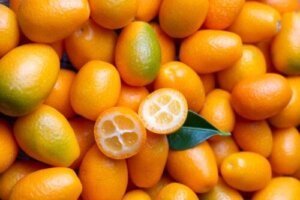What Are Kumquats and How Are They Used in Cooking?


Written and verified by the nutritionist Saúl Sánchez Arias
Kumquats are very small citrus fruits that can resemble a tangerine. They’re exotic in nature and have many beneficial properties for the body. They were originally cultivated in China and stand out because the whole fruit is edible, even the skin.
Here we’ll discuss all the benefits of consuming this food. Introduced in the context of a balanced diet they have many assets. However, they aren’t easy to obtain, as they’re rare fruits in Western countries.
Nutritional properties of kumquats
When talking about the nutritional value of kumquats, we must highlight its low caloric intake of only 71 kilocalories per 100 grams (4 oz). This is because 80% of the kumquat is made up of water. Among the macronutrients, the presence of carbohydrates stands out, specifically simple sugars, with 15.9 grams per 100 grams of fruit. Proteins and fats are practically residual in this case.
However, the situation changes when it comes to micronutrients. It contains significant amounts of vitamin C, up to 43 milligrams. At the same time, it has phytonutrients with antioxidant capacity that neutralize the production of free radicals. It also contains fiber, which allows a more gradual absorption of the sugars it provides.
Find out more: 8 Symptoms of a Vitamin C Deficiency
Benefits of kumquat

We’re going to tell you about all the benefits we can have from the consumption of kumquats and what science says about it.
1. A lower risk of getting sick
Vitamin C is one of the nutrients involved in the proper functioning of the immune system. This is evidenced by a study published in the journal Nutrients. Thus, a regular consumption of it ensures the reduction of the incidence of common colds and other infectious pathologies.
2. Reduced constipation
Surely you have already heard that fiber intake is key to combating constipation. This substance has been shown to be able to increase the volume of the fecal bolus, stimulating the mechanoreceptors of the intestine and generating a more powerful intestinal peristalsis. In this way, the stools pass more efficiently through the digestive tract.
At the same time, this same fiber can create a feeling of satiety, which reduces the risk of snacking on unhealthy products between meals. Thus, a hypocaloric diet is easier to plan.
3. Effective against anemia
Kumquats’ vitamin C content helps maximize iron absorption at an intestinal level, according to research published in the Asia Pacific Journal of Clinical Nutrition. In this way, it reduces the risk of developing anemia, a pathology that causes extreme fatigue and tiredness, and which occurs as a result of an inefficient intake of the aforementioned mineral.
How to eat them?
Kumquats can be eaten naturally, including the skin that gives it a sweet taste, or by preparing products such as jams or jellies, in which you can take advantage of the bitter touch of the pulp. It’s also possible to prepare meat sauces with this food. It can even be used in smoothies to maximize their nutritional value.
They also keep well. They can last up to 4 days at room temperature and can remain unchanged for up to 2 weeks when refrigerated. Another option to freeze them and make smoothies with them.
Find out more: A Simple Recipe for Homemade Peach Jam
Uses of kumquats in the kitchen

As we said previously, there are 2 typical culinary uses of kumquat, the elaboration of jams or the preparation of sauces.
Jams
In this case, you can make it in a similar way to the jams of any other fruit. The fruit is cooked with a good amount of sugar until a thick texture is formed and you then beat it. Another option is to add some kumquats when you prepare orange marmalade.
Sauces
For sauces, it’s best to prepare a mayonnaise base and then season it in order to improve its organoleptic characteristics. In this sense, kumquats can be added, together with culinary spices, to form an ideal product that combines well with meats.
Kumquats, relatively unknown fruits
Kumquats are rare in Western countries, but they contain many important nutrients. They stand out for their vitamin C content and antioxidants, which help to prevent the development of complex pathologies.
Another of its main characteristics is that the whole fruit is edible, including the skin. In addition, they’re easy to add to different culinary recipes, which will enhance these recipes significantly.
All cited sources were thoroughly reviewed by our team to ensure their quality, reliability, currency, and validity. The bibliography of this article was considered reliable and of academic or scientific accuracy.
- Carr AC, Maggini S. Vitamin C and Immune Function. Nutrients. 2017 Nov 3;9(11):1211.
- Christodoulides S, Dimidi E, Fragkos KC, Farmer AD, Whelan K, Scott SM. Systematic review with meta-analysis: effect of fibre supplementation on chronic idiopathic constipation in adults. Aliment Pharmacol Ther. 2016 Jul;44(2):103-16.
- Pauline M, Verghese ST, Srinivasu BY, Bose B, Thomas T, Mandal AK, Thankachan P, Kurpad AV. Effect of ascorbic acid rich, micro-nutrient fortified supplement on the iron bioavailability of ferric pyrophosphate from a milk based beverage in Indian school children. Asia Pac J Clin Nutr. 2018;27(4):792-796.
This text is provided for informational purposes only and does not replace consultation with a professional. If in doubt, consult your specialist.








